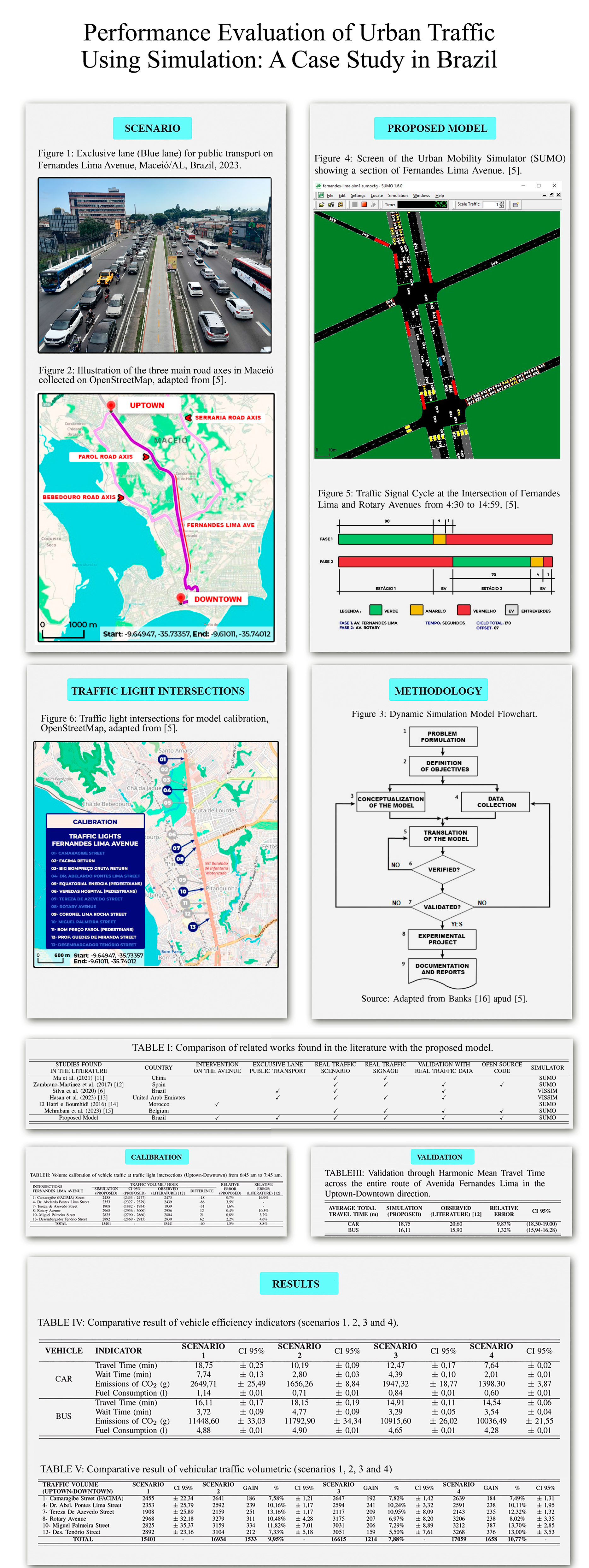Performance Evaluation of Urban Traffic Using Simulation: A Case Study in Brazil
Keywords:
Urban Traffic, Simulation, Traffic-Lights, SUMOAbstract
As a result of a fast-growing population, an increasing number of vehicles on the road, and inadequate public policies, metropolitan areas in Latin America are dealing with significant traffic congestion problems. Most cities do not have real-time urban traffic control systems. Therefore, the use of simulation software is a cost-effective solution to evaluate and reduce congestion in metropolitan areas. This paper seeks to assess urban traffic performance using the Urban Mobility Simulator (SUMO) on Fernandes Lima Avenue, the most important thoroughfare in Maceió, Alagoas, Brazil, which features distinctive characteristics such as a dedicated lane for public transportation and three segments with pedestrian traffic lights. Comparing the real observations with the simulation results, it was confirmed that the model provided accurate estimates, with errors of less than 5% for vehicle traffic volume and 10% for total travel time. After conducting experimental studies on four different scenarios, including the current state (1), no blue lane (2), no pedestrian traffic lights (3), and no blue lane and no pedestrian traffic lights (4), it was found that significant improvements in efficiency indicators, such as travel time, waiting time, fuel consumption, and carbon dioxide emissions, could be achieved. Scenarios 2, 3, and 4 were particularly effective, resulting in volumetric increases of 9.95%, 7.88%, and 10.77%, respectively, in vehicle traffic.
Downloads
References
DETRAN/AL, “Departamento estadual de trânsito alagoas, indicadores de trânsito do estado de alagoas.” in http://indicadores.detran.al.gov.br/veiculos/, 2022. Acesso em 18 de julho de 2022.
V. E. Fausto Filho et al., “Diagnóstico de trânsito em espaço intra-urbano: estudo de caso do eixo viário fernandes lima,” 2018.
S. M. d. I. MACEIÓ/AL, “Obras da ciclovia da fernandes lima avançam e vão beneficiar 200 mil ciclistas,” 2021. Acesso em 24 de maio de 2021.
C. Serviço Geológico do Brasil, “Estudos sobre a instabilidade do terreno nos bairros pinheiro, mutange e bebedouro, maceió (al): volume i, relatórios técnicos,” tech. rep., CPRM, 2019.
F. V. Pais, B. Nogueira, and R. G. S. Pinheiro, “Avaliação de desempenho do tráfego urbano usando simulação: Estudo de caso em maceió/al,” 2022.
L. G. O. d. Silva et al., “Faixa azul em maceió: avaliação dos ganhos de velocidade dos ônibus por microssimulação do tráfego,” 2020.
D. Panovski and T. Zaharia, “Simulation-based vehicular traffic lights optimization,” in 2016 12th International Conference on Signal-Image Technology & Internet-Based Systems (SITIS), pp. 258–265, IEEE, 2016.
J. Ferrer, M. López-Ibáñez, and E. Alba, “Reliable simulation-optimization of traffic lights in a real-world city,” Applied Soft Computing, vol. 78, pp. 697–711, 2019.
S. A. Celtek, A. Durdu, and M. E. M. Alı, “Real-time traffic signal control with swarm optimization methods,” Measurement, vol. 166, p. 108206, 2020.
C. D. Pegden, S. R. E, and R. P. Sadowski, Introduction to Simulation Using SIMAN. 2nd ed., McGraw-Hill, New York, 1995.
X. Ma, X. Hu, T. Weber, and D. Schramm, “Evaluation of accuracy of traffic flow generation in sumo,” Applied Sciences, vol. 11, no. 6, p. 2584, 2021.
J. L. Zambrano-Martinez, C. T. Calafate, D. Soler, and J.-C. Cano, “Towards realistic urban traffic experiments using dfrouter: Heuristic, validation and extensions,” Sensors, vol. 17, no. 12, p. 2921, 2017.
U. Hasan, H. AlJassmi, and A. Hasan, “Microsimulation modelling and scenario analysis of a congested abu dhabi highway,” Eng, vol. 4, no. 3, pp. 2003–2014, 2023.
C. El Hatri and J. Boumhidi, “Q-learning based intelligent multi-objective particle swarm optimization of light control for traffic urban congestion management,” in 2016 4th IEEE International Colloquium on Information Science and Technology (CiSt), pp. 794–799, IEEE, 2016.
B. B. Mehrabani, L. Sgambi, S. Maerivoet, and M. Snelder, “Development, calibration, and validation of a large-scale traffic simulation model: Belgium road network,” in SUMO Conference Proceedings, vol. 4, pp. 15–27, 2023.
J. Banks, Handbook of simulation: principles, methodology, advances, applications, and practice. John Wiley & Sons, 1998.
OpenStreetMap, “Plataform,” 2022. [Accessed 05-july-2022].
J. Garcia-Nieto, A. C. Olivera, and E. Alba, “Optimal cycle program of traffic lights with particle swarm optimization,” IEEE Transactions on Evolutionary Computation, vol. 17, no. 6, pp. 823–839, 2013.
P. Neis, D. Zielstra, and A. Zipf, “The street network evolution of crowdsourced maps: Openstreetmap in germany 2007–2011,” Future Internet, vol. 4, no. 1, pp. 1–21, 2012.


